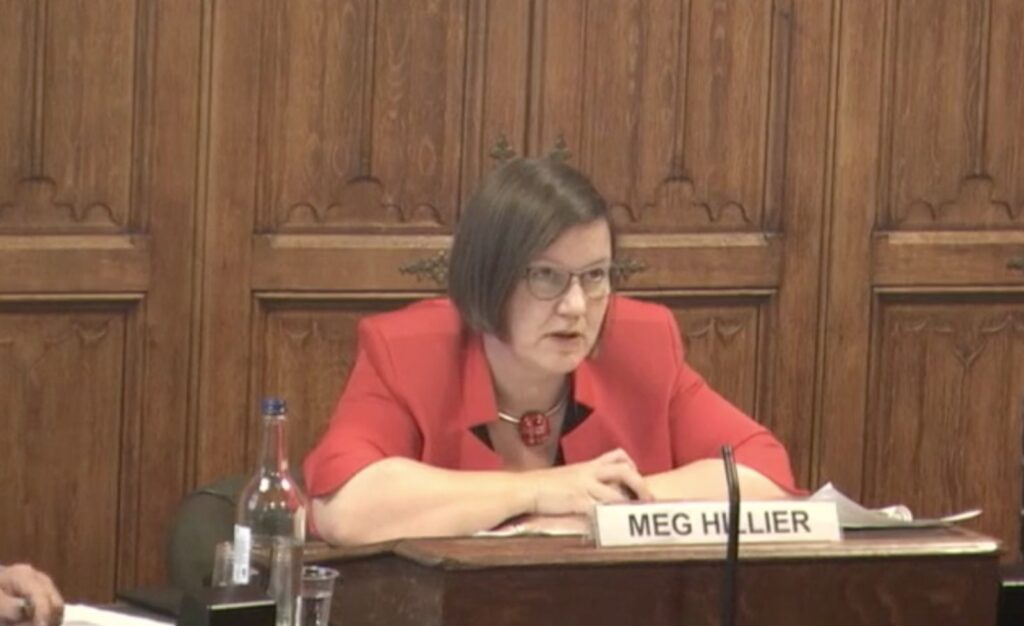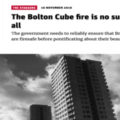A billion to be doled out by first-come, first-served applications irrespective of risk in a building or its ability to pay

By Harry Scoffin
The head of an influential House of Commons select committee has ordered the ministry of housing to “put a stop to the bickering” and end the “misery and uncertainty” facing thousands of leaseholders in unsafe apartment buildings.
Meg Hillier, who chairs the Public Accounts Committee, said that the government had spectacularly failed in its handling of the cladding crisis, with its post-Grenfell initiatives little more than “pie-in-the-sky promises” because MHCLG could not “plan, resource, or deliver”.
“Thousands of people have been condemned to lives of stress and fear in unsaleable homes with life-changing bills: for the works and for the fire-watch that is necessary to allow them to sleep at night until it is done,” she said.
“The government must step up and show that it will put a stop to the bickering over who is responsible, who’s going to pay for the remediation – and just put this right.”
The verdict of Labour politician Ms Hillier, who is herself a leaseholder in a cladding site where – exceptionally – the cladding bills are being met by the original developer – was shared by her nine Conservative colleagues, who all put their names to the highly critical cladding report.
It lays blame at the door of MHCLG for presiding over a faulty regulatory system which has materially disadvantaged purchasers of flats, despite being told by officials that the construction industry was to blame for dangerous flats.
PAC condemns “badly missed” target to make thousands of Grenfell-style cladding homes safe – Committees – UK Parliament
ldquo;Put a stop to arguing over who’s responsible and put this right” “System-wide failure” in “not fit for purpose” building regulations system leaves tens of thousands to live in fear and financial limbo Read the report summary Read the conclusions and recommendations Read the full report Read the full report (PDF)
In its report, the PAC also determined it was “unacceptable” that 300 high-rise blocks are encased in aluminium composite material (ACM) more than three years since the same combustibles caused the the deaths of 72 people in west London’s Grenfell Tower.
Noting that MHCLG “missed its target badly” for the removal of Grenfell-style cladding from residential buildings, which had been June 2020, the PAC has recommended that officials come clean on data and publish monthly updates on projected completion dates of the remaining ACM blocks without identifying them.
The PAC said its investigation has led it to believe the government “has no convincing plan” for how it will meet its “ambition” for the completion of ACM removal works by the end of 2021.
MHCLG’s administration of the “first-come, first-served” £1bn Building Safety Fund has also been criticised for not prioritising the most at-risk properties.
Not only were officials unable to justify why the grant money for non-ACM cladding removal will cover a third of the total estimated £3-3.5bn costs, “but could not say how it would sort applications in rank order, nor … guarantee that funding would be prioritised according to financial need”.
The dispensing of a billion pounds of taxpayer money by the end of the 2020-21 was flagged as another concern, with the PAC recommending that the ministry of housing provides its value for money framework and risk assessment to the committee within three months.
The PAC claimed officials’ approach to this latest taxpayer-backed cladding removal scheme is at odds with the carefulness that has defined the earlier £600m Grenfell cladding initiative.
“While the Department has made £600 million available to fund the replacement of aluminium composite material (ACM) cladding (as used on Grenfell) on buildings above 18 metres, by April 2020 it had only paid out £134 million, due in part to difficulties in working with private building owners,” said the report.
The PAC observed that leaseholders are often forced customers when its comes to insurance and “waking watch” fire warden bills, “with little say” while their building awaits or undergoes cladding remediation.
It noted cases where insurance premiums have surged by over 400% and highlighted anonymous evidence from one cladding site where leaseholders’ reserve fund, which had been accumulated after 20 years of saving, “were exhausted in around three months as a result of waking watch costs”.
The scrutiny committee have recommended that the ministry of housing explains in writing within the next three months what it is doing to provide leaseholders with greater cost transparency and how it will get building owners to “meet a standard of service in communication with residents”.
‘Stop arguing and put this right’: MPs condemn government ‘failure’ over dangerous cladding
The government has no convincing plan for how to meet its target for remediating buildings with deadly cladding and must “put a stop to arguing over who’s responsible and put this right”, a committee of MPs has said.
Although officials claimed that the stalling of the flats market from the EWS1 fire certification is an “industry issue”, the PAC have found that MHCLG “has not done enough” to respond to the nil valuations, remortgaging blockages and insurance hikes that have become more common place since “changes to departmental guidance” in January, which brought sub-18m blocks into scope.
It has ordered MHCLG to expedite cross-sector work to resolve the issues that have emerged from the fire safety evaluation process and write to the PAC with its assurance that the situation has been brought under control by state intervention.
In comments to The Guardian, the Local Government Association’s building safety spokesperson Lord Porter – a Conservative peer – strongly endorsed the work of Ms Hillier and colleagues:
“We urge the government to act on all the committee’s recommendations without delay. Issues raised in the report around insurance, mortgages and the skills shortage rightly highlight the serious challenges that need to be overcome if all buildings are to be made safe.
“Leaseholders and residents have suffered enough. The government has accepted that the building safety system has failed for decades and it must now deal with the consequences, which includes funding remediation in full and pursuing those responsible through the courts.”
UK government has failed to deliver on cladding promises
Tens of thousands of high-rise residents have been left trapped in unsellable homes because the UK government has failed to deliver on “pie-in-the-sky promises” to fix them, the public accounts committee has said. More than three years after the Grenfell Tower disaster in west London killed 72 people, the powerful cross-party committee of MPs said it was “unacceptable” that similar cladding remains on hundreds of residential buildings.
The PAC report follows a probe by the National Audit Office in June which found that officials were struggling with the nature of leasehold ownership and offshore freehold owners. The public spending watchdog had warned that they still had a “long way to go” to make all high-rises free of Grenfell combustibles.
Investigation into remediating dangerous cladding on high-rise buildings – National Audit Office (NAO) Press release
Progress is being made in removing dangerous cladding from high-rise residential buildings following the Grenfell Tower fire. However, the pace of works has been faster in some types of building than others and progress in the private residential sector has been slower than the government expected, according to today’s report by the National Audit Office.





 LKP survey of EWS1 shows that 90% of cladding sites DO need remediation
LKP survey of EWS1 shows that 90% of cladding sites DO need remediation






















Excellent cross-party report from the PAC. Given insurance companies are also a driver of the current crisis with their high premiums and shifting demands on leaseholders – seemingly driven by profit considerations alone – could the PAC (or other Parliamentary Committee) inquire into the Insurance industry? As with the banking crisis, we need a ‘Fred Goodwin moment’ to attempt to get these seemingly untouchable insurance bosses to explain their exploitation of the cladding crisis. Government should also be asked (again) why it is not coming forward with insurance guarantees for cladding stricken sites as for high flood risk properties?